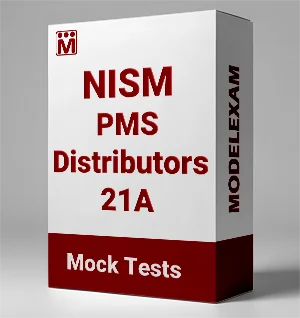NISM Series XXI-A Portfolio Management Services (PMS) Distributors Certification Examination
What is the meaning of 'XXI-A' in NISM Series XXI-A Portfolio Management Services (PMS) Distributors Certification Examination?
It is '21A'. 'XXI' is the roman numeral for '21'.
What are the different names of PMS Distributors Exam?
pms exam, nism xxi a, pms certification, nism 21a, nism pms certification, pms distributors, nism pms exam, pmsd certificate, nism portfolio management services distributors Exam, pms exam nism, pmsd exam, nism pmsd exam, nism series xxia, nism series 21a.
There are 2 exams under NISM Portfolio Management Services Certification. Which should One Choose?
PMS Distributors (NISM 21A) is for agents who are going to sell PMS services to clients (Sales).
Portfolio Managers (NISM 21B) is for portfolio managers who are managing clients' portfolios (Trading & Investments).
NISM 21A Portfolio Management Services (PMS) Distributors Exam mock test

NISM 21B Portfolio Managers Exam mock test

Where can I get NISM 21A PMS Distributors exam Study Material? ?
Click here for NISM 21A PMS Distributors exam Study material
How to take free mock tests for NISM XXI-A Distributors exam in our website ?
Where can I get training for NISM series XXI-A PMS Distributors exam ?
Where can I get NISM Series 21A PMS Distributors Exam Dates ?
Click here for NISM Exam dates
How to do NISM Exam registration ?
NISM exams Registration Procedure
Weightages : NISM Series XXI-A PMS Distributors exam
| Unit No. | Unit Name | Weightages |
|---|---|---|
| Unit 1 | Investments | 07 |
| Unit 2 | Introduction to securities markets | 05 |
| Unit 3 | Investing in stocks | 10 |
| Unit 4 | Investing in fixed income securities | 05 |
| Unit 5 | Derivatives | 05 |
| Unit 6 | Collective Investment Vehicles | 05 |
| Unit 7 | Role of portfolio managers | 10 |
| Unit 8 | Operational aspects of portfolio managers | 13 |
| Unit 9 | Portfolio management process | 15 |
| Unit 10 | Performance measurement and evaluation of portfolio managers |
10 |
| Unit 11 | Taxation | 05 |
| Unit 12 | Regulatory, governance and ethical aspects of portfolio managers |
10 |
Assessment Structure : NISM Series 21A PMS Distributors exam
| Question Format | Multiple Choice Questions |
| Number of Questions | 100 questions |
| Marks per Question | 1 |
| Total Marks | 100 |
| Duration | 2 hours |
| Passing Score | 60% |
| Negative Marking | 10% of marks assigned to question |
Syllabus : NISM 21A PMS Distributors exam
I: Investment Landscape
- Define Investment
- Investment versus Speculation
- Know the objectives of Investments
- Estimating the required rate of return
- Various types of risks
- Types of Investments - Role and Characteristics
- channels for making investments
- Investments through managed portfolios
II: Introduction to Securities Markets
- Define Securities Markets
- Primary and secondary securities markets
- Market participants and their activities
- Various market participants and their activities
III: Investing in Stocks
- Equity as an investment
- Risks of equity instruments
- Diversification of risk through equity instruments
- Equity research and stock selection
- Understand Estimation of intrinsic value
- Explain Technical Analysis
IV: Investing in Fixed Income Securities
- Overview of Fixed Income Securities
- Bond Characteristics
- Determinants of bond safety
- Valuation of Bonds
- Measuring price volatility for bonds
V: Derivatives
- Definition of Derivatives
- Types of derivative products
- Structure of derivative markets
- Purpose of Derivatives
- Introduction to Commodity and Currency Futures and Options
- Underlying concepts in derivatives
- Derivatives in PMS
VI:Collective Investment Vehicles
- Concept and Role of Collective Investment Vehicles
- Legal Structure of Mutual Fund, ReITS, InvITs and AIFs
- Types and Working of Mutual Funds, ReITS, InvITs and AIFs
VII: Role of Portfolio Managers
- Overview of portfolio managers in India
- Types of portfolio management services
- Organizational Structure of PMS in India
- General Responsibilities of a Portfolio Manager
- Administration of investor’s portfolio
VIII: Operational Aspects of Portfolio Managers
- Entities which can invest in PMS
- Disclosures to the prospective clients
- Process of on boarding of clients
- Liability in case of Default
- Redressal of Investors grievances
- Disclosures to the regulator
- Costs, expenses and fees of investing in PMS
IX: Portfolio Management Process
- Importance of Asset allocation decision
- Understanding correlation across asset classes and securities
- Steps in Portfolio Management Process
- Asset allocation decision
- Re-balancing of Portfolio
X: Performance measurement and evaluation of Portfolio Managers
- Parameters to define performance – risk and return
- Rate of return measures
- Risk measures
- Risk adjusted return
- Performance Evaluation: Benchmarking and peer group analysis
- Performance attribution analysis
- Performance reporting to the Investor
- Valuation of Securities by Portfolio Manager
- Due Diligence and Portfolio Manager selection
XI: Taxation
- Categories of Investors
- Taxation of different asset classes
- Understand if Fees and Expenses are tax deductible
- Tax Reporting and Compliance
- Portfolio Investment Scheme for NRIs
XII: Regulatory, Governance and Ethical Aspects of Portfolio Managers
- Prevention of Money Laundering Act, 2002
- SEBI (Prohibition of Insider Trading) Regulation 2015
- SEBI (Prohibition of Fraudulent and Unfair Trade Practices Relating to Securities Market) Regulations, 2003
- Securities and Exchange Board of India (Portfolio Managers) Regulations, 2020
- Investor Charter for Portfolio Management Services

